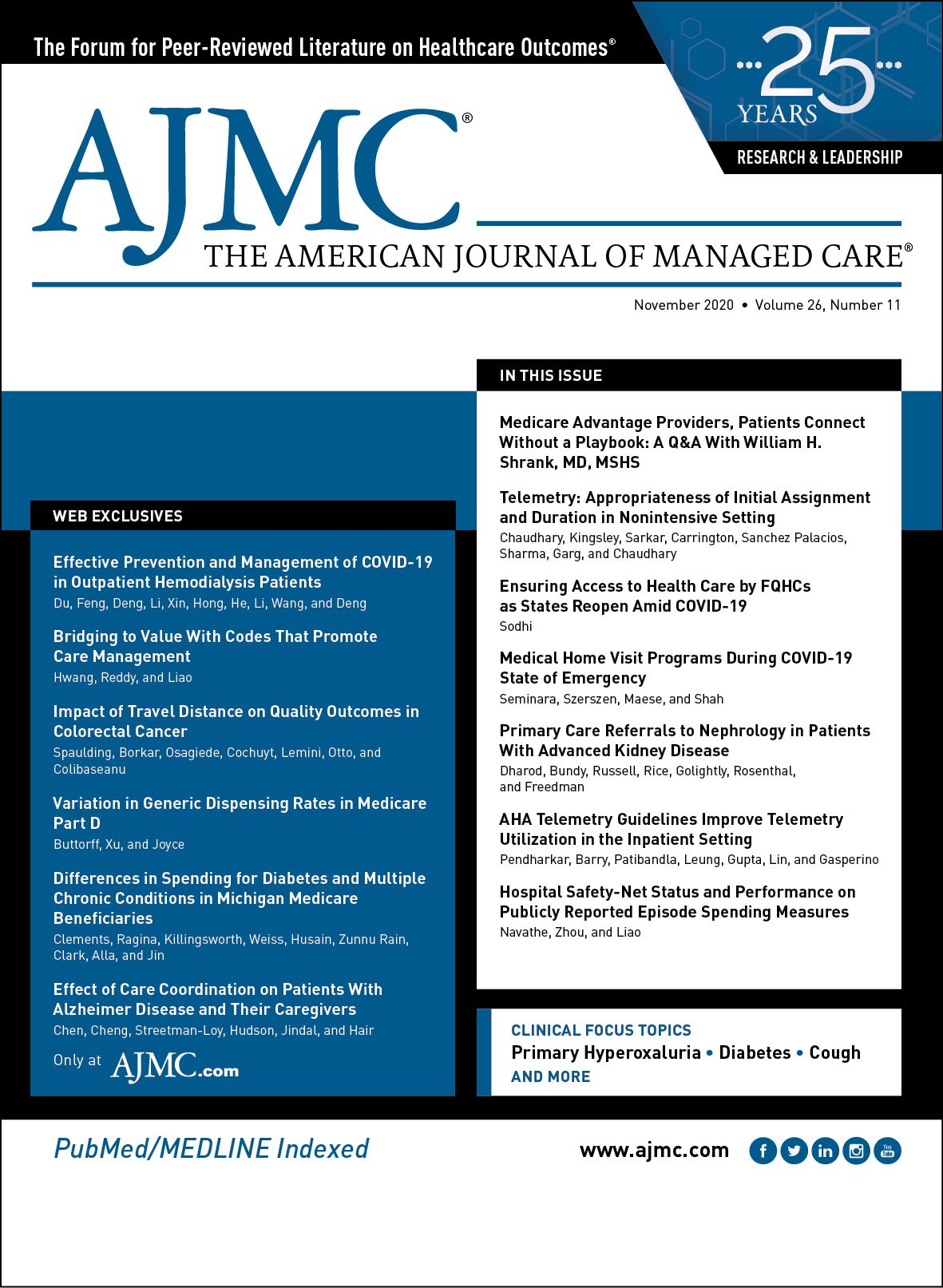Publication
Article
The American Journal of Managed Care
Effective Prevention and Management of COVID-19 in Outpatient Hemodialysis Patients
Author(s):
The authors introduce a mobile phone app that may effectively prevent and manage coronavirus disease 2019 (COVID-19) in outpatient hemodialysis patients in Sichuan Province, China.
Am J Manag Care. 2020;26(11):e342-e343. https://doi.org/10.37765/ajmc.2020.88510
Takeaway Points
Coronavirus disease 2019 (COVID-19) is a pandemic disease that has had a major impact on the world health care system and has brought catastrophic damage to the world and seriously affected normal life. Although the incidence of COVID-19 has slowed in China, new COVID-19 cases have been reported in hospitals there. China gradually realized that hospitals with concentrated personnel may become a potential danger area for new outbreaks because patients receiving outpatient hemodialysis can go back and forth between the hospital and their own residences every day. They may become the group who will be most easily infected with severe acute respiratory syndrome coronavirus 2, the virus that causes COVID-19. We introduce a mobile phone app that may effectively prevent and manage COVID-19 in patients requiring outpatient hemodialysis in Sichuan Province.
Coronavirus disease 2019 (COVID-19) is a pandemic disease that has had a major impact on the world health care system.1 As of June 1, 2020, 6,096,628 confirmed cases and 369,456 deaths had been reported worldwide. The pandemic has wreaked catastrophic damage internationally and has seriously affected the normal lives of people everywhere.
The incidence of COVID-19 in China, which has had a great impact on the country, especially its tourism and catering industries, has slowed; most new cases are in foreign patients and there are no more than 100 cases. However, COVID-19 cases have recently been reported in hospitals in many cities of Heilongjiang Province. Authorities gradually realized that hospitals may become a potential danger area for new outbreaks. Health administration departments all over China have imposed stricter control requirements on hospitals, including nucleic acid testing for newly admitted patients and those who accompany them, temperature testing, and epidemiological history registration for all outpatients.2
However, outpatient hemodialysis patients may become the group who will be most easily infected with severe acute respiratory syndrome coronavirus 2, the virus that causes COVID-19.3 Unlike inpatients, who can be managed in a closed environment, outpatient hemodialysis patients can go back and forth between the hospital and their own residences every day. Additionally, they differ from sporadic outpatients in that outpatients on hemodialysis will go to the hospital very frequently and gather together for a long time (4 hours or longer). It is very easy for a COVID-19 outbreak to occur among outpatient hemodialysis patients.4 Then, once patients are infected, it is hard to find an alternate place where hemodialysis treatment for so many patients can be properly arranged. Therefore, methods to carry out effective prevention and control of COVID-19 for outpatients on hemodialysis are worth exploring. Here, we introduce a mobile phone app, Sichuan Health Pass, which is widely used in Sichuan Province, China.
This app can be embedded in WeChat, the most widely used social platform software in China (eAppendix Figure A [available at ajmc.com]). After clicking this app in WeChat to register with one’s real name, it is automatically filled in with all information on the registrant’s identification card and their mobile phone contact information. After logging in, a health QR code is displayed, which refreshes dynamically every day (eAppendix Figure B). When the registrant enters the hospital or high-risk gathering area, the security personnel require the registrant to show their health QR code before being allowed inside.
Normally, the QR code is green, indicating that the registrant has minimal risk of COVID-19 epidemiology. Once the registrant has had contact with patients infected with or suspected to have the virus or has recently visited the COVID-19 epidemic area, the health administration department will automatically report the registrant’s identification number to the software, and the registrant’s health QR code will turn orange. Once the registrant receives a diagnosis of suspected or confirmed COVID-19, the health QR code will turn red. An orange or red QR code will cause the registrant to be unable to enter the controlled area or be forced to isolate.
A nurse is on duty at the door of the hemodialysis center. Each patient who comes to the hemodialysis center is required to have their temperature checked and show their health QR code. If it is green, they can be treated normally. Patients with an orange code will be moved to the corner of the last shift of dialysis treatment; at the same time, the patient is required to take protective measures, such as wearing a mask, and nurses will take 3-tier prevention measures to treat all patients. If the code is red, they will be refused entry and asked to go to the designated hospital for isolation dialysis treatment.
Nearly 40,000 outpatients are receiving hemodialysis in Sichuan Province, China. After the application of this mobile phone software for COVID-19 prevention and control, the vast majority of hospitals reported that the screening work intensity and the pressure of prevention and control were greatly reduced. It is no longer necessary to fill in the form of epidemiological inquiry for dialysis patients every day, and it is no longer a concern that patients may hide possible epidemiological contacts. The operation of the whole hemodialysis center has gradually recovered to a calmer state. Most importantly, since the mobile phone software has been put into use, no new event of aggregated infection among outpatients with hemodialysis in Sichuan Province has occurred.
We will continue to discuss and analyze the role of the Health Pass program for early warning of COVID-19 in the future.
Acknowledgments
Yaqin Du and Jin Feng contributed equally to this work and are listed as co–first authors.
Author Affiliations: Department of Nephrology (YD, YL, DH, QH, GL, LW, FD) and Department of Traditional Chinese Medicine (JF), Sichuan Provincial People’s Hospital, University of Electronic Science and Technology of China, Chengdu, China; Sichuan Center for Disease Control and Prevention (JD), Chengdu, China; Hemodialysis Center, Sichuan Center for Disease Control and Prevention (YX), Chengdu, China; Department of Nephrology, Chengdu Jinniu District People’s Hospital, Sichuan Provincial People’s Hospital, Jinniu Hospital (YD, FD), Chengdu, China.
Source of Funding: This work was supported by Sichuan Science and Technology Program (2019YFH0069), Sichuan Provincial People’s Hospital Clinical Research and Transformation Fund (2018LY12), and Primary Health Development Research Center of Sichuan Province Program (swfz18-Z-6).
Author Disclosures: The authors report no relationship or financial interest with any entity that would pose a conflict of interest with the subject matter of this article.
Authorship Information: Concept and design (YD, JF, FD); drafting of the manuscript (YD); critical revision of the manuscript for important intellectual content (JF, FD); provision of patients or study materials (JD, YL, YX, DH, QH, GL, LW); obtaining funding (FD); administrative, technical, or logistic support (JF, JD, YL, YX, DH, QH, GL, LW, FD); and supervision (YD, JF, JD, YL, YX, DH, QH, GL, LW, FD).
Address Correspondence to: Fei Deng, MS, Department of Nephrology, Sichuan Provincial People’s Hospital, University of Electronic Science and Technology of China, Chengdu, 610072, China. Email: dengfei@med.uestc.edu.cn.
REFERENCES
1. Alberici F, Delbarba E, Manenti C, et al; Brescia Renal COVID Task Force. Management of patients on dialysis and with kidney transplantation during SARS-CoV-2 (COVID-19) pandemic in Brescia, Italy. Kidney Int Rep. 2020;5(5):580-585. doi:10.1016/j.ekir.2020.04.001
2. Tu H, Tu S, Gao S, Shao A, Sheng J. Current epidemiological and clinical features of COVID-19; a global perspective from China. J Infect. 2020;81(1):1-9. doi:10.1016/j.jinf.2020.04.011
3. Rombolà G, Brunini F. COVID-19 and dialysis: why we should be worried. J Nephrol. 2020;33(3):401-403. doi:10.1007/s40620-020-00737-w
4. Brioni E, Leopaldi D, Magnaghi C, et al. Covid-19 in patients on dialysis: infection prevention and control strategies. Article in Italian. G Ital Nefrol. 2020;37(2):1-6.




